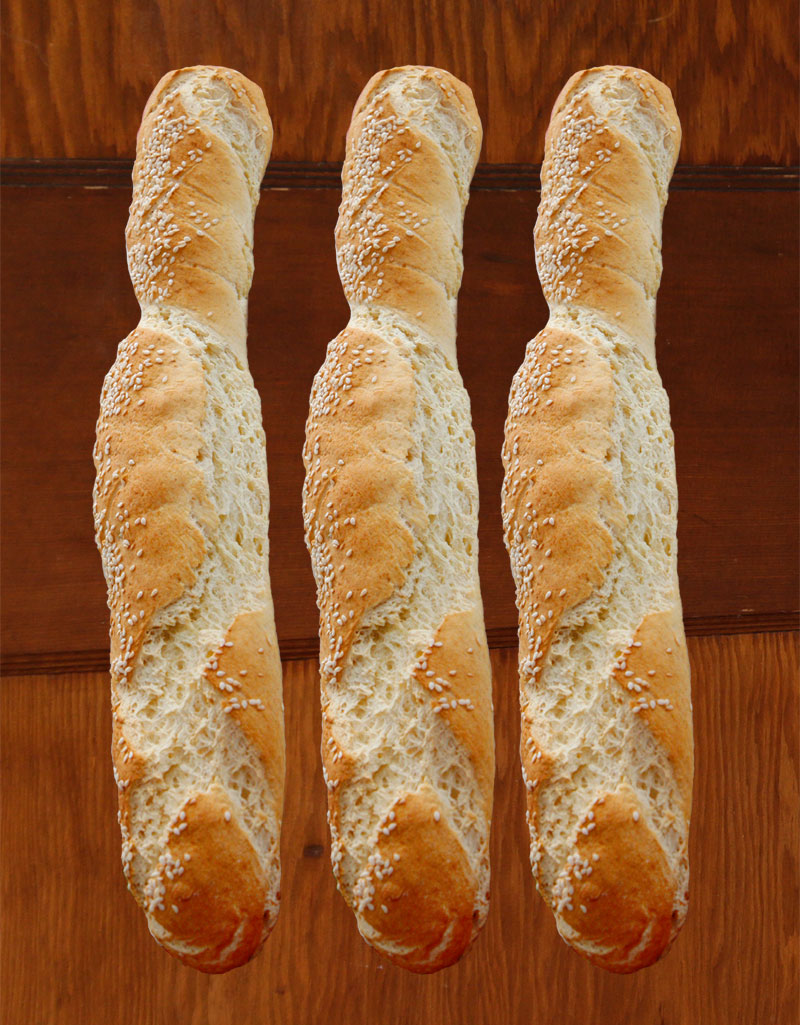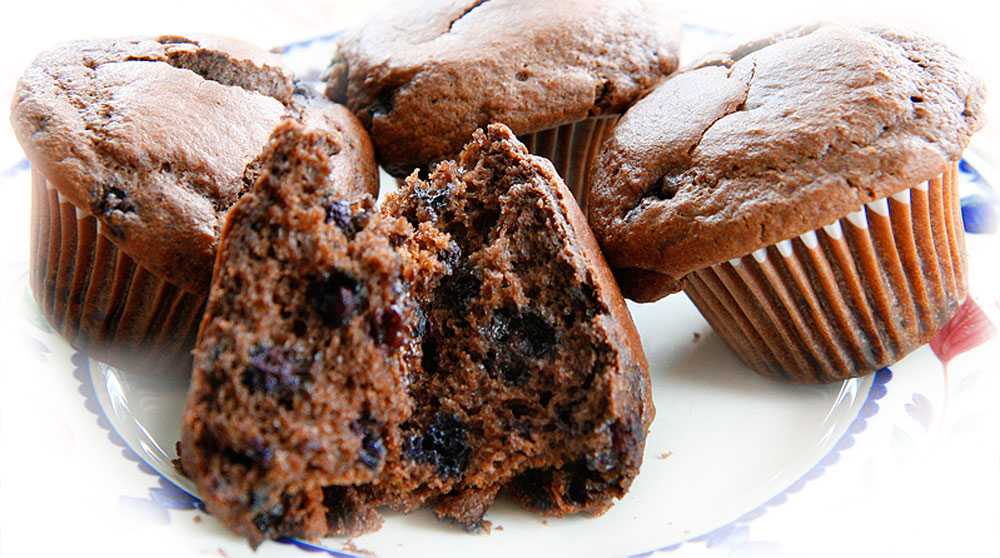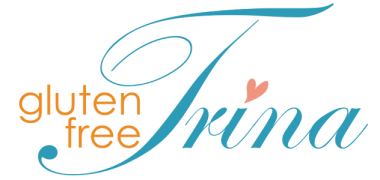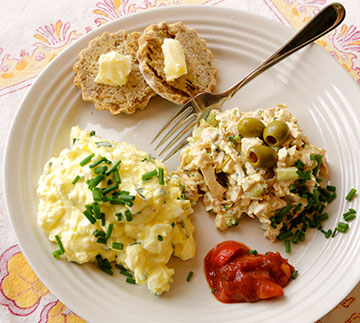Finding out you must eat a gluten-free diet for life is difficult at first. I remember the feeling of not being able to eat some of my favorite foods… ever again! Just looking at the brightly frosted doughnuts in a Cafe even now brings a twinge. I am sure you know the feeling!

The image is a composite of the same delicious loaf.
It took a while to re-orient myself. I made a lot of foods that were not great. Too many failures to count. But when you need to eat, well… they say, “Necessity is the mother of invention!”

I tried several brands of pre-made mixes. However, sometimes a particular flour brand might not be in stock the next time I go to the grocery store. Substitutes don’t always function the same way. Some members of the family had other food sensitivities that could be included in the substitute.
Then I started blending my own gluten-free baking mixes at home. I could get the raw ingredients as they were readily available either locally at health and specialty food stores or online. This, of course, had its own problems since I had to adjust the ingredients to work properly. Needless to say, my early attempts were less than satisfactory. But the family persevered. Thankfully they appreciated my efforts, and with each attempt, somehow, I got better at it.
You may discover, as I did in those early days, school lunches in your child’s drawer in their bedroom. I was horrified; what did they eat instead? Or did they not eat? I always tried to make a good breakfast for sure!
Trina
I could not afford to keep discarding foods because they didn’t taste as good as my wheat baking had. Just like every mom with a family, you need to make something to feed your family. You don’t want them to turn up their noses at what you make. Especially when it is a health matter for some or everyone in your home, food that is safe for your family to eat and tastes good is essential.
It took a lot of experimenting. I started with one flour mix that worked. As time went on and my go-to “All-Purpose” blend just did not cut it for some recipes, I went on to develop more gluten-free flour combinations. As I recall, it took about five years to formulate my four original flour mixes and three bread mixes.

There are 3 series designed to take other food sensitivities into account.
Finally, I could bake and cook meals, similar to what I had done before going gluten-free. The only difference was that it took particular ingredients in particular amounts and blended ahead of time to do the job. I didn’t like adding multiple flours each time I wanted to bake, so the make-ahead combinations saved time. Knowing approximately how much food I would need at the start of each month, I then made enough mixes to cover it. I always tried to have something on hand. Just like I had had gluten-full flours previously. I now had rid my cupboard of any offenders to our new diet and had a new supply of gluten-free flour that could work.
My family and friends were the best motivation to develop tasty foods. If what you make does not taste good, chances are they won’t eat it. Or they might take a small bite just to be polite. Later, when I got better at it, I took samples to Celiac Support Group meetings and social events. When people ate a whole piece or asked for more, I knew I had something.
One day at a time, I found solutions that worked. I was a busy wife and mom with a job. I wanted to save time. I needed to save money. We all needed balanced meals with adequate nutrition to assure long-term health. Besides that, I had grown up enjoying delicious traditional home baking. I did not want our children to feel left out. After all, food is not only a dietary necessity. It is a social activity. So many great family memories are made in the kitchen and at holiday dinners.
We needed solutions that fit our lifestyle, not making our lives fit into what we could or could not eat.
It takes planning! Even with the best meal-planning strategies, you sometimes need to whip up something at the drop of a hat. If you have the ingredients in your cupboards or freezer, you can.
All of us find our cupboards to be almost bare at times. Time to go grocery shopping again. But we need something now. This is when staple items that keep well can be a godsend. For people like us, who live gluten-free, it is not as easy all of a sudden to just go out to eat.
Stock up on gluten-free food you CAN eat!
Since fresh food spoils, it is important to have a supply of foods on hand that will keep and be available when you run out of fresh stuff.
I was fortunate that my mother was a make-ahead type of person. We lived in the country, and it was not always convenient to drive into town. She always thought ahead and had something hidden away. I remember once when all she had was oatmeal and a few canned vegetables. She made oatmeal soup; it was more delicious than you can imagine. You can find the recipe in this article.
Getting back to the early days of cooking gluten-free for our family of four with two growing boys with healthy appetites. I pre-made flour and bread mixes. Baked bread and made frozen portions as well as ready-to-bake pizzas. I even made dry soup mixes and other things that could help with meals in a pinch.

Muffins were a favorite in our house, so with the flour mix all made, it was easy to add a few fresh ingredients and bake. With boys in the house, it is nothing to see a dozen muffins disappear the same day.
There are more gluten-free cereals and porridge mixes available today. But back then, there was little other than oats. Some of us could eat certified gluten-free oats, others not. So I came up with a cereal blend, which is both a flour and a baking mix made from several naturally gluten-free whole grains. This meant I could add more wholegrain nutrition to almost anything I baked a spoonful at a time. I kept this separate from the other gluten-free flour mixes so that when I wanted traditional-looking white baked goods, I could do that. I still love the taste and functionality of my whole-grain blend.
It was a good beginning. I enjoyed sharing recipes and, eventually, the blend formulas with others, and having them commercially blended for a time was very rewarding. I won’t go into more about that here. You can read about our family’s journey into the food business in my cookbook. Gluten-Free, You Can Do It.
Even now that there are only two of us living at home, I bake ahead and freeze buns cut in half and slices of bread. Then I just pop what I need in the toaster oven, and in no time, we have delicious bread. Of course, I can’t resist having some fresh out of the oven too. I still blend mixes ahead of time, just in smaller amounts. So I can make pie crusts, scones, and puff pastry ahead so that all I have to do is bake when some company visits.
More reasons to blend your own gluten-free mixes.
- Blending your own mixes at home, you include only ingredients that are right for you -if you have other food sensitivities in addition to gluten, no problem.
- If you want to buy only organic ingredients, that is a choice you can make when you blend your own.
- Suppose you’re buying prepackaged foods. You don’t always know what grade or quality of ingredients the manufacturer is using.
- Often it saves money to blend your own
- You can blend one mix that makes multiple recipes instead of buying one pre-made mix that makes only one thing.
- Standardizing the various ingredients used in your blends will optimize the results in your baking.
- It does take additional time to blend your own mixes upfront. But it saves time, frustration, and your pocketbook later.
Plan Ahead
Suppose you like to cook, plan holiday meals, or foods to take along for a social occasion. In that case, you will probably have your favorite recipes you want to make. How many times have you gone to your local store and found the mix or ingredient not in stock? Do you find yourself substituting another brand? This can mean your favorite recipe may not taste or turn out the same.
Baking gluten-free is not as easy as baking with wheat flour. Introducing a variable in your ingredients may not work the same as something you used in the past.
It doesn’t matter if you’re cooking for just yourself, two of you, or a family; making your own mixes ahead can save you both time and money. You can make a little or a lot, depending on your needs.
I think a lot of frustration happens when a recipe doesn’t turn out quite the same as it did another time. Standardizing your pantry with gluten-free flour and bread mixes reduces the chance of things going wrong.
Many of us like to cook foods or bake to take along something we can eat safely. Usually, we look for recipes that everyone will enjoy rather than just taking something for ourselves. When you make food to bring along, you want people who eat wheat to taste and not be put off by the term gluten-free. Often, when I have brought something along, I just let their taste buds be the judge.
Some prepared mixes have sugar as the first ingredient. Or sometimes, the amount of salt is too much. When you blend your own, you can take these things into consideration and add what you feel is necessary. Or you can use a sugar or salt substitute. I don’t like things to be too sweet, so when I see a package mix with sugar as the primary ingredient, I know it is going to be too sweet for our taste buds and long-term health.
The “Gluten-Free, You Can Do It Cookbook” has Three Series of Mixes to accommodate those who have food sensitivities or allergies in addition to gluten.
I hope you’ll have a ‘Look Inside’ at the first 39 pages on Amazon. There are photographs of some of the items you can make.
It is surprising how many people do have additional food allergies or intolerances. As well as my original formulas, there are two new series of mixes in my cookbook. If you require free-from Corn, Nightshade, Tapioca, or Rice, you will find numerous blends that are safe for you. All are free from Tree-Nuts, Peanuts, Beans, Soy, Dairy, Sesame, and Peas. Every mix makes multiple recipes, and there is a chapter of recipes for each mix, over 300 in all.
While developing these new mixes, I compared recipes made with the original blends that I knew were good. Sometimes I like the new version even better.
There are easy recipes in the cookbook and also more difficult ones to satisfy foodies. But if you are like me and crave something you have loved before, it is worth the extra effort. Not all of these recipes are ones that would be made regularly. Some are special occasion recipes.
The most demanding recipe to create was the Puff Pastry. It is not difficult to make now since the recipe is complete. It just took many tries. Puff Pastry has its own ingredient profile, which is corn and nightshade-free. It has several useful attributes. You make it ahead of time in small increments. Freeze the results and bake before serving. Just like wheat-based puff pastry, you can reheat it or eat it cold, and it remains tasty.
I’ve always wanted to share with others, like members of our family who can’t eat gluten. Now you can make your own delicious foods and not feel deprived.
Once you try making your own mixes and get beyond the first stages of going gluten-free, you won’t think this diet is so bad after all. In many ways, it keeps us from the so-called junk foods. Eating a wholesome, balanced diet is always good for you. All you have to do is eliminate the gluten and whatever other food intolerance you may have.
Enjoy your food today!




